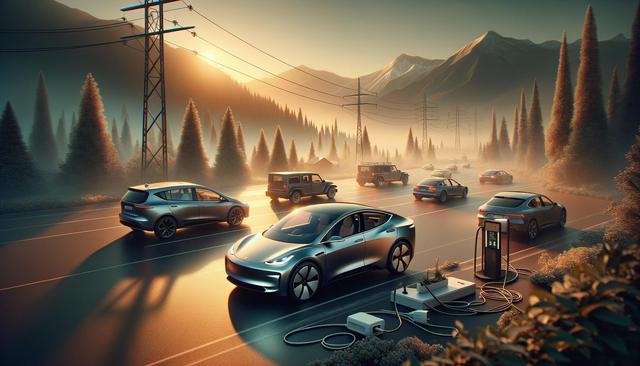Longest Range Ev Crossovers Of 2025: Which Models Go The Distance?
Electric vehicle crossovers are becoming increasingly popular, especially as new models in 2025 push the boundaries of driving range and efficiency.

Understanding the Importance of Range in Electric Crossovers
As electric vehicles (EVs) continue to gain traction among drivers, one of the most critical factors influencing purchasing decisions is range. For many consumers, range anxiety—the fear of running out of battery power before reaching a charging station—is a primary concern. Electric crossovers, given their versatile nature and family-friendly design, are especially appealing when they combine spacious interiors with long-distance capability. In 2025, several manufacturers have responded to this demand by releasing EV crossover models that can travel impressive distances on a single charge. These advancements are largely due to improvements in battery technology, energy management systems, and aerodynamics.
Range is particularly important for drivers who frequently commute long distances or enjoy road trips. Unlike urban electric cars that may only need to cover short daily routes, crossovers often serve as primary family vehicles and need to accommodate longer journeys. With that in mind, the 2025 lineup of electric crossovers includes several models that offer extended ranges, reducing the need for frequent charging stops and enhancing overall convenience.
Top Long-Range Electric Crossovers to Watch in 2025
The 2025 model year introduces a variety of electric crossovers with impressive range capabilities. While range alone shouldn’t be the sole criterion in choosing a vehicle, it’s undoubtedly a critical feature for many potential buyers. Among the standout models are several offering ranges well above 300 miles, with a few nearing or exceeding the 400-mile mark under standard testing conditions. These figures reflect real-world usability and make these vehicles suitable even for longer road trips.
Some of the long-range EV crossovers expected to make a mark in 2025 include:
- Models that offer over 350 miles per charge, making them ideal for interstate travel
- Options with fast-charging capabilities, allowing up to 200 miles of range in just 30 minutes
- Vehicles designed with improved aerodynamics to reduce drag and enhance efficiency
Each of these features contributes not just to range, but also to the overall driving experience, making these crossovers practical and appealing for a broad range of users.
Battery Innovations Driving Longer Ranges
The push for longer-range electric crossovers in 2025 is largely powered by advancements in battery technology. New cell chemistries—such as solid-state batteries and high-density lithium-ion batteries—have significantly increased energy storage capacity without adding excessive weight. These innovations are not only enabling higher range figures but also improving safety and reducing charging times.
Battery management systems (BMS) have also evolved. These systems now allow for better thermal regulation, which is essential in maintaining optimal battery performance over time. In addition, regenerative braking systems are more efficient than ever, recapturing more energy during deceleration and feeding it back into the battery.
Other engineering improvements include:
- Lightweight materials to reduce vehicle mass
- Improved powertrain components for more efficient energy use
- Integrated software that optimizes driving patterns for extended range
All these factors contribute to the remarkable range figures seen in the latest 2025 EV crossover models.
Charging Infrastructure and Real-World Usability
Even with extended range capabilities, the practicality of electric crossovers still depends heavily on the availability and reliability of charging infrastructure. In 2025, the landscape for EV charging continues to evolve, with significant investments in fast-charging networks and home charging solutions. These improvements are aimed at making EV ownership more convenient and accessible for the average driver.
For many users, the ability to charge at home overnight remains one of the most convenient aspects of owning an electric vehicle. However, for those who rely on public charging stations, the presence of high-speed chargers along major travel routes is essential. Many of the new long-range EV crossovers support ultra-fast charging, which can dramatically reduce downtime during trips.
Key considerations for real-world usability include:
- Availability of charging stations along daily routes and travel corridors
- Charge speed and compatibility with different charging networks
- Integration of route planning tools that factor in charging stops
Combined with extended range, these infrastructure improvements make EV crossovers more viable than ever for a wide range of driving needs.
What to Consider Before Choosing a Long-Range EV Crossover
While range is a vital factor, it’s not the only one to consider when selecting an electric crossover in 2025. Buyers should also evaluate factors such as interior space, cargo capacity, driving dynamics, and available technology. Some long-range models may prioritize efficiency over performance, while others strike a balance between spirited driving and practical range.
It’s also important to consider total cost of ownership. While some of the longest-range vehicles may carry a higher upfront cost, they may offer savings over time through reduced fuel and maintenance expenses. Additionally, government incentives and rebates can help offset the initial purchase price, depending on the buyer’s location.
Before making a decision, prospective EV owners should:
- Compare range estimates under real-world conditions
- Check for compatibility with home and public charging solutions
- Test-drive multiple models to assess comfort and performance
Taking the time to evaluate different options will help ensure that buyers find an electric crossover that meets their specific needs and lifestyle.
Conclusion: The Future of Long-Range Electric Crossovers
With the 2025 electric crossover market showcasing impressive advancements in range, battery efficiency, and charging infrastructure, drivers have more compelling reasons than ever to consider making the switch to electric. These vehicles offer a blend of practicality, sustainability, and modern technology that aligns well with the needs of today’s consumers. Whether for daily commuting, family travel, or long-distance road trips, the latest long-range EV crossovers provide an increasingly viable and attractive alternative to traditional gas-powered vehicles. As the technology continues to evolve, it’s likely that even more efficient and accessible options will emerge, helping to drive the future of transportation forward.